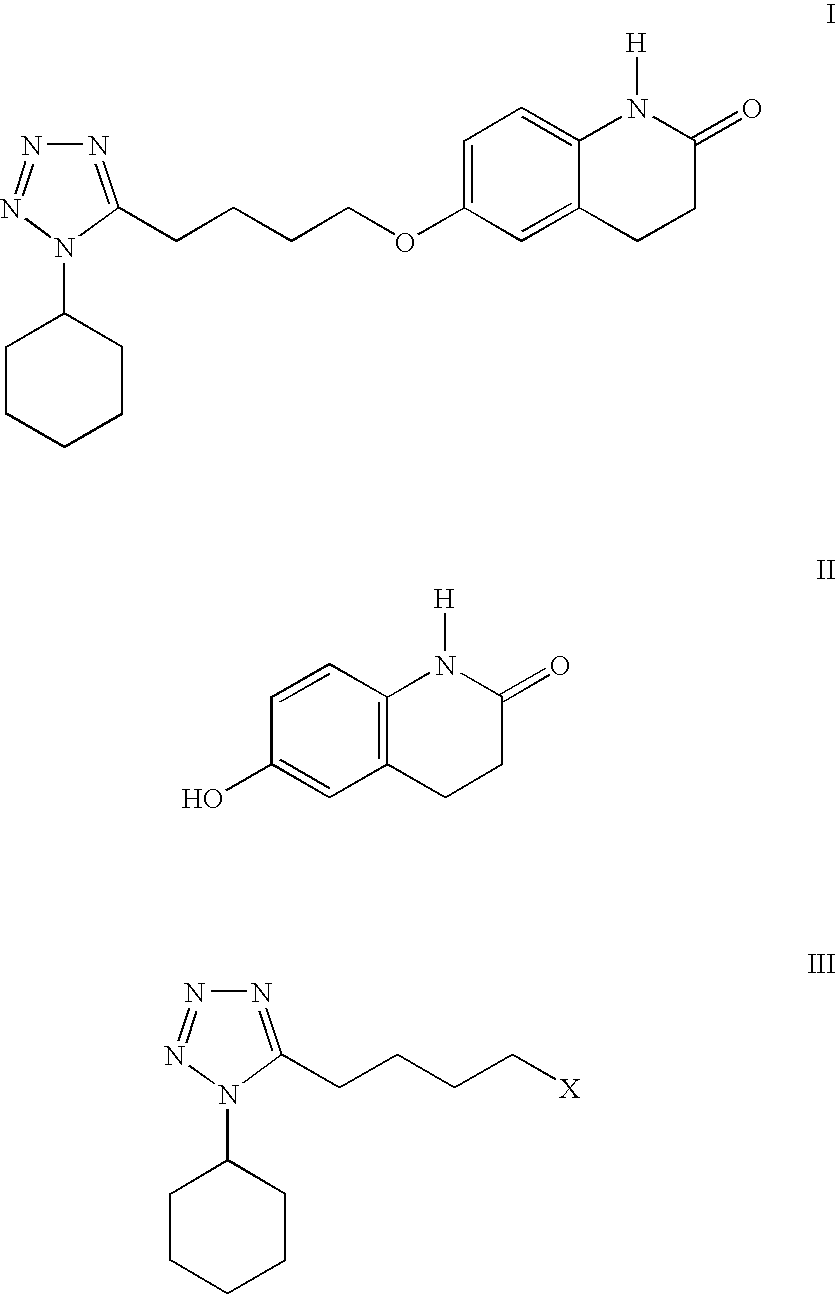Process for the production of cilostazol
a technology of cilostazol and process, applied in the field of process for producing cilostazol, can solve the problems of increasing process complexity, inability to meet the needs of some bases, complicated process work-up procedures, etc., and achieves high homogeneous process efficiency, large-scale production, and greater conversion of starting materials ii.
- Summary
- Abstract
- Description
- Claims
- Application Information
AI Technical Summary
Benefits of technology
Problems solved by technology
Method used
Image
Examples
example 1
[0030] To a mixture of 6-hydroxy-3,4-dihydroquinolinone (II) (75.0 g, 0.46 mol) in 1-methyl-2-pyrrolidinone (150 mL) was added 50% aqueous sodium hydroxide solution (36.8 g, 0.46 mol) and water (75 mL). The mixture was stirred and heated to 50-60° C. to give a solution. 1-Cyclohexyl-5-(4-chlorobutyl)-tetrazole (III, X=Cl) (100.5 g, 0.414 mol) was added and the resulting mixture was heated to 85-95° C. and stirred for 3 hrs. The reaction was determined to be complete by TLC. After being cooled to 50-60° C., isopropyl acetate (225 mL) and water (450 mL) were added and the reaction mixture was heated to reflux (about 80° C.). The mixture was cooled to 0-5° C. and stirred for 2 hrs. The resulting suspension was filtered, rinsed with isopropyl acetate (150 mL), water / 1-methyl-2-pyrrolidinone (7 / 2 v / v, 150 mL) and water (150 mL) and dried to give 130.66 g (yield. 85.4%) of cilostazol. HPLC purity: 99.53%.
example 2
[0031] A hot solution (70-75° C.) of cilostazol (23 g) in 1-methyl-2-pyrrolidinone (69 mL) was slowly added over a period of 5-10 min into water (345 mL) at 0-5° C. with stirring. The suspension was stirred at 0-5° C. for 1-2 hrs, filtered and rinsed with water (40 mL) and methanol (20 mL). The solid was dried under vacuum at 55-60° C. to give 22.1 g (yield 96%) cilostazol as a white powder. Particle size distribution: d(0.1)=0.71 micrometres, d(0.5)=5.94 mircrometres, d(0.9)=30.59 micrometres.
example 3
[0032] A hot solution (70-75° C.) of cilostazol (20 g) in 1-methyl-2-pyrrolidinone (40 mL) was slowly added over a period of 5-10 min into toluene (250 mL) at 0-5° C. with stirring. The suspension was stirred at 0-5° C. for 1-2 hrs, filtered and rinsed with toluene (100 mL). The solid was dried under vacuum at 55-60° C. to give 18.2 g (yield 91%) cilostazol as a white powder. Particle size distribution: d(0.1)=0.80 micrometres, d(0.5)=3.90 mircrometres, d(0.9)=25.56 micrometres.
PUM
| Property | Measurement | Unit |
|---|---|---|
| Temperature | aaaaa | aaaaa |
| Temperature | aaaaa | aaaaa |
| Equivalent mass | aaaaa | aaaaa |
Abstract
Description
Claims
Application Information
 Login to View More
Login to View More - R&D
- Intellectual Property
- Life Sciences
- Materials
- Tech Scout
- Unparalleled Data Quality
- Higher Quality Content
- 60% Fewer Hallucinations
Browse by: Latest US Patents, China's latest patents, Technical Efficacy Thesaurus, Application Domain, Technology Topic, Popular Technical Reports.
© 2025 PatSnap. All rights reserved.Legal|Privacy policy|Modern Slavery Act Transparency Statement|Sitemap|About US| Contact US: help@patsnap.com



